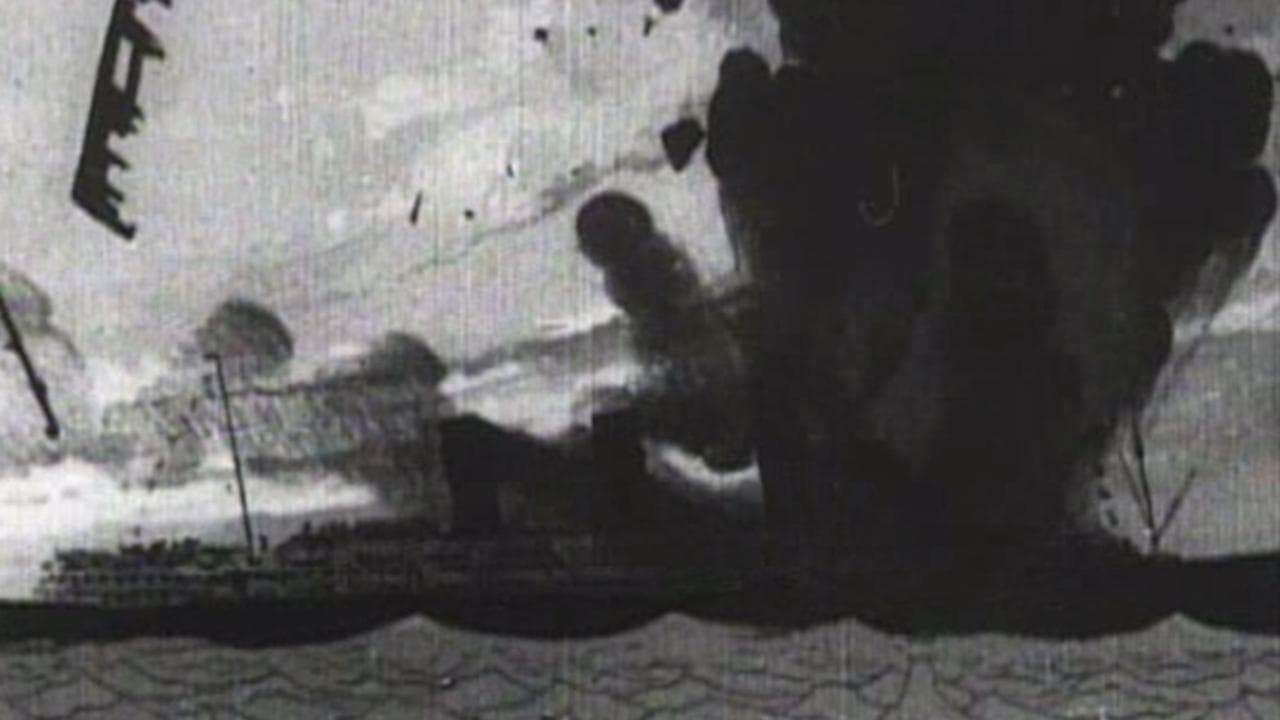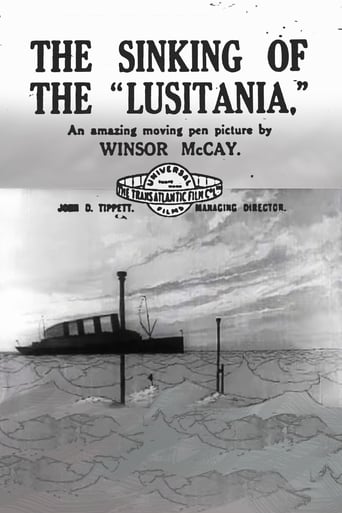

AN OFTEN HELD and widely spread attitude concerning animation is that it is kids' stuff and not proper fare for we 'sophisticated' adults. All work in this film discipline are somehow lumped into the not so flatteringly used term of "Cartoons." Just check how they are invariably classified as being 'Children's'.WE MUST CONFESS that we succumbed to some of this propaganda; which would appear to be very difficult to resist. When we add to that the widely held notion that all of today's pictures are superior to any from "the old days." These are falsehoods that would be easily put to rest if only one would view some of the early animation work of pioneers in the genre; whose names are unknown to most.GOING STRAIGHT TO the top of the list and the head of the class is one Winsor McCay. Mr. McCay was already an outstanding draftsman and true artist; who had already been well known for his comic strip, LITTLE NEMO IN SLUMBERLAND, which had run for years; being syndicated to many newspapers in both the United States and throughout the world.THE METHOD USED by McCay made use of many thousands more drawings than would have been required only a few years later. This was due to the invention of clear plastic cells; which would be alternated sequentially over a single background. The painting of characters, vehicles, animals, etc. on the cell and then photographed over the background eliminated possibly as much as 60% of the drawing required.BUT IT IS this quality of rendering the scenes that are so lifelike that gives such a dramatic and moving feel to this short. There needn't have been more length to the story telling, when the actual sinking of the Lusitania was completed in about 15 minutes! WE FOUND THIS "cartoon" to be eerily haunting, even disturbing. In particular, we are referring to the depiction of the great ship sinking, one end going down with the other high in the air. All during this time, McCay has given us the sight of many people (in long shot); who are helplessly and desperately jumping many feet off of the ship to an equally unsure fate in the North Atlantic.WHEN WE SCREENED this short, we were instantly put in the same mental state we all had when viewing those poor, helpless murdered individuals who jumped from the World Trade Center on 9/11/2001.NOW YOU SEE what we mean about seeing this being a highly dramatic experience! DO YOU STILL call them "cartoons?"
... View MoreI first became aware of Windsor McCay when years ago I read those surreal dream comics he did in the first decade of the 20th Century "Dreams of a Rarebit Fiend" and "The Adventures of Little Nemo in Slumberland". I never saw anything quite like his art work (for that time - it was the age of "Mutt and Jeff" and "The Katzenjammer Kids". They just were amazing to me. Then I learned that he was the first major American cartoonist who tried his hand at motion picture cartoons. I saw part of his "prehistoric" joke, GERTIE THE DINOSAUR, in some television shows - but only part. I had heard of his twelve minute long cartoon of the sinking of the R.M.S. Lusitania, but had no real knowledge of it. Then, last Friday, I finally saw it on the internet. As a meticulously drawn cartoon of that sad, sea atrocity of May 7, 1915 it is remarkable. As has been said on this thread before by others, when the ship is sinking we see little figures jumping off the ship and drowning in the ocean. Hideous in reality, that McCay did it shows great care in trying to seem accurate. He even shows that one of the smokestacks of the ship had fallen in the attack. McCay must have studied survivor's reports. Only one major fact he got wrong - but understandably so. He insists that there were two torpedoes fired by the U-Boat. Walter Schweiger's notebooks survived, and he insisted he only fired once. Today it is believed a second explosion occurred from either a boiler being hit, or coal dust exploding, or (this has been somewhat discredited) hidden explosives being taken to Europe for the war effort being blown up. Whatever it was, it probably blew out the side of the boat and caused the ship to sink in 18 minutes (not quite the 15 minutes McCay mentions in the cartoon).It was meant for war propaganda - part of President Wilson's propaganda campaign under newspaperman George Creel, which made all Germans look anti-human. Today there would be a more balanced approach to the story - a tragedy of three governments (Britain, Germany, and the United States) who managed to bungle matters so that 1,198 people (124 of them Americans) died by drowning or freezing or injuries from the explosions. The real tragedy is show by photos that are superimposed of some celebrities who were lost. Most are forgotten now, but were major figures in 1915. Alfred Vanderbilt, of the great railroad family, is shown. So is Charles Frohman, the theatrical producer of plays by men like Clyde Fitch and James Barrie (including PETER PAN - in the recent film about Barrie Frohman was played by Dustin Hoffman). Also the dramatist Charles Klein (who did the libretto for Sousa's best operetta EL CAPITAN), and the editor and writer Elbert Hubbard (who wrote THE MESSAGE TO GARCIA). It is an interesting aspect that these real photos are used, but drawing the figures might have seen somewhat sacrilegious towards these famous dead people.Unless a film about the sinking is done by James Cameron as a follow-up to TITANIC, this is the closest we will ever get to a film on the loss of the "Lucy". That is, unless one thing turns up. If you read A.A. Hoehling and Mary Hoehling's book, THE LAST VOYAGE OF THE LUSITANIA, they mention that a newspaper cameraman was on the ship who actually took motion pictures of the panic and the destruction as it went under. He said they'd be the greatest pictures ever taken. This idiot was lost in the disaster and his camera was never found. But was he wrong? Movies of the sinking of the "Andrea Doria" are still shown and one photo of it going under won a Pulitzer Prize for the photographer (who shot from a plane). Similarly, in 1928, the S.S. Vestris sank in a storm off the Virginia Capes with the loss of 130 people. A photo of the fear crazed passengers trying to stand on the crazy slanted deck of the "Vestris" was taken, survived, and was published. It too won the Pulitzer Prize for best news photography. Maybe, if the idiot and his camera, or just his camera, survived he would be honored today as a pioneer in photographic journalism. Apparently it didn't, but we do have McCay's excellent, fairly realistic cartoon to look at instead.
... View MoreAnimation historians must view this film immediately, but I suppose if you can find one McCay cartoon you can find them all - they're compiled on the 'Animation Legend' video and DVD. 'Lusitania' is the film where McCay tries to escape the caricatural confines of the animated picture to produce a serious and moving film, and damn, he succeeds. The meticulous care which he put into the thousands of drawings necessary for this short cartoon meant that by the time it was finished, it was barely topical and WWI was over, leaving its calls for vengeance somewhat stranded. However, as a study of technique it is perhaps unsurpassed. McCay's animation has a dimensionality which is worlds apart from the character animation of Koko the Klown or Felix the Cat, perhaps a deliberate differentiation from such gentle entertainments. The grim monochrome images of the Lusitania's stern raised in the air while hundreds of people leap to their deaths while remind most audiences of shots from James Cameron's 'Titanic'. While the barely-concealed rage and maudlin tributes to the famous noblemen who died in the sinking (as opposed the penniless plebs who we can afford to forget) now appear unpalatably heavy-handed, the elegant curls of smoke from the stricken vessel are simply powerful cinematic touches which seal McCay's reputation as one of the great film artists of the silent era. If only he, and not Disney, had become the template for the future of American animation...
... View MoreAlthough Winsor McCay is primarily known for such whimsical flights of fantasy as "Gertie the Dinosaur" and the comic strip "Little Nemo in Slumberland", this recreation of the great ocean-liner tragedy is just as remarkable. Painstakingly realistic, the graphic detail and fluidity of motion in this cartoon are far ahead of their time. This was actually the first film to use cel animation, as the amount of detail McCay envisioned would have made drawing each picture individually near impossible. In fact, you really have to look closely at the human figures to tell that it isn't actual live footage. The torpedoes striking the hull, the subsequent explosions, the lifeboats and ropes flying over the sides, the passengers jumping overboard, the attempts at rescue, and the tragic fates of those unfortunates adrift in the ocean are all wonderfully and harrowingly realised. That the quality of this film isn't in the greatest condition anymore (at least the print of it I saw wasn't) somehow only makes it feel even more authentic. The final shot packs an emotional wallop infinitely greater than anything in Cameron's TITANIC.
... View More